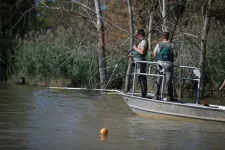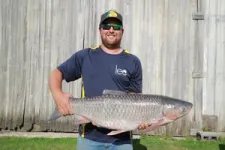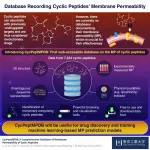(Press-News.org) New research reveals the progress scientists at The University of Toledo are making in their ongoing efforts to capture and remove invasive grass carp from the Great Lakes.
Researchers based at the UToledo Lake Erie Center created a new way to estimate the abundance of invasive “sleeper” species in freshwater ecosystems and help guide management strategies.
Using data collected during their efforts to remove invasive grass carp from Lake Erie and its tributaries, the aquatic ecologists and environmental statisticians developed a model that can be used to estimate the amount of any rare fish early in the invasion process.
Right now, invasive grass carp are relatively rare and difficult to catch.
Published in the journal Biological Invasions, the paper lays out foundational work to determine how many grass carp are likely present at one time in the Sandusky River in Ohio, which flows into Lake Erie and is the largest source of grass carp production in the Great Lakes.
UToledo strike teams have been working for years with state and federal agencies to keep invasive grass carp at bay before it’s too late.
Scientists and students use electrofishing boats and a variety of nets to remove adult grass carp so the threatening fish population can’t spread to other Great Lakes. The teams also sample grass carp eggs during spawning seasons in several rivers to learn when and where they are spawning.
Estimates from the new model show that from 2018 to 2020, there were probably less than 200 grass carp residing in the Sandusky River: 183 in 2018, 164 in 2019 and 167 in 2020. Overall during that time period, the strike teams captured 96 grass carp in 64 events out of 380 attempted removal events.
“As we capture new grass carp, we can refine the estimate each year to describe trends in the number of fish,” said Dr. Christine Mayer, a professor in the Department of Environmental Sciences at UToledo’s Lake Erie Center. “This will help determine how effective our control strategies have been at reducing the population and preventing them from reproducing or spreading.”
Mayer said more recent preliminary results suggest that the number of fish in the river has gone down, signaling progress against the invasive species.
“Our control work is the most likely explanation for the reduced number of grass carp,” Mayer said. “More grass carp have been removed from the Sandusky River than any other location and more effort has been put into the Sandusky than any other location.”
Native to eastern Asia and introduced to the U.S. in the 1960s for pond control, grass carp feed on vegetation. They pose a risk to wetlands and the fish, birds, reptiles and amphibians who use that habitat, but grass carp do not eat plankton and are unlikely to compete directly with native fish. Grass carp do not jump and are primarily herbivorous.
Wild adult grass carp pose significantly different risks to the Lake Erie ecosystem than bighead carp and silver carp, which are the two invasive carp species of greatest concern in the Mississippi River basin. Both bighead carp and silver carp consume plankton, and if these species were to make their way into the Great Lakes basin, they would compete for the same source of food that ecologically and economically important native fish species need to survive. Silver carp are well-known for their jumping ability.
“One of the goals of carrying out research on grass carp is to provide information about how other invasive carp species might behave if they ever arrive in the Great Lakes,” Mayer said.
The new model created at UToledo can be used for estimating the number of any rare species, including endangered or threatened species targeted with conservation strategies.
But in this case, the researchers are focused on an invasive species with the aim to keep it rare, prevent its spread and maybe even eliminate it from the system altogether.
“Working with a rare species makes it difficult to estimate the numbers in the population, and standard statistical techniques are not appropriate,” said Dr. Song Qian, a professor in the UToledo Department of Environmental Sciences. “And data generated from control strategies, such as removing invasive species, are usually not suited to conventional statistical modeling approaches.”
Oftentimes, fish populations are estimated using a “mark and recapture” procedure where fish are initially captured and marked in some way, such as a fin clip, and then released. In subsequent sampling, the ratio of marked-vs.-unmarked fish can be used to quantify the total number present. However, this process only works when the target species is abundant, which does not hold true for grass carp.
UToledo scientists came up with a way to use species-control data to quantify abundance.
“Our model modifies another popular estimation approach,” Qian said. “We have included experimentally measured data on the probability of detecting grass carp with the field gear used on the project in order to isolate the estimate of numbers present. Typically, the probability of finding a species goes up as it becomes more abundant. Therefore, providing independent information on the probability of detection was crucial to obtaining a valid estimate for this rare species.”
Partners on the research, titled “A Restructured Bayesian Approach to Estimate the Abundance of a Rare and Invasive Fish,” include UToledo, Ohio Department of Natural Resources, Great Lakes Fishery Commission, U.S. Fish and Wildlife Service, Michigan Department of Natural Resources and U.S. Geological Survey.
END
New tool shows progress in fighting spread of invasive grass carp in Great Lakes
UToledo researchers created a new way to estimate the abundance of invasive “sleeper” species in freshwater ecosystems and help guide management strategies.
2023-04-05
ELSE PRESS RELEASES FROM THIS DATE:
Recent advances in space chemistry research
2023-04-05
Space is the great unknown — very few of us will ever experience what it’s like to visit another planet or moon, and so much is yet to be discovered. Below are some recent papers published in ACS journals that report advances toward understanding whether certain minerals, compounds or even life itself could form on other worlds. Reporters can request free access to these papers by emailing newsroom@acs.org.
“Immunoanalytical Approach for Detecting and Identifying Ancestral Peptide Biomarkers in Early Earth Analogue Environments”
Analytical Chemistry
March 16, 2023
These authors reasoned that if they could analyze “resurrected” ...
Survey of allergists/immunologists reveals management of hereditary angioedema differs by region
2023-04-05
ARLINGTON HEIGHTS, Ill. (April 5, 2023) – Hereditary angioedema (HAE) is a disease that, due to its rare nature, can pose difficulties for both patients and medical professionals. A new survey of allergists/immunologists from the American College of Allergy, Asthma and Immunology (ACAAI) shows that diagnosing, treating and managing this condition can be challenging for patients and healthcare providers - including patients in rural areas. An article about the survey is published in Annals of Allergy, Asthma and Immunology, ACAAI’s scientific journal.
HAE is caused by a genetic mutation, and there are different types. It is a hereditary disease. The symptoms of HAE ...
SynGAP Research Fund awards a collaborative grant to Tang Lab & AXONIS Therapeutics
2023-04-05
PALO ALTO, Calif. (April 5, 2023) – SynGAP Research Fund (SRF), a 501(c)(3) public charity whose mission is to improve the quality of life for SYNGAP1 patients through the research and development of treatments, therapies and support systems, today announced they have awarded a $130,000 collaborative grant to the lab of Xing Tang, PhD at Boston Children's Hospital & AXONIS Therapeutics to investigate the treatment effects of KCC2-enhancing small molecule compounds in SYNGAP1 haploinsufficiency.
Principal Investigator of translational neuroscience at AXONIS, Dr. Kadam, has been working with the SRF community for many years. While at Johns Hopkins, she gave a popular SRF ...
Manganese in Central Valley water threatens fetuses and children
2023-04-05
Water in California’s Central Valley contains enough manganese to cause cognitive disabilities and motor control issues in children, and Parkinson’s-like symptoms in adults.
A naturally occurring metal, manganese is found in water supplies throughout the world. It is regulated as a primary contaminant in many Southeast Asian countries where the climate causes it to leach into groundwater. However, in the U.S. it is regulated only as a secondary contaminant, meaning no maximum level is enforced.
A ...
Do altered gut microbes affect risk of attention-deficit/hyperactivity disorder?
2023-04-05
New research published in the Journal of Child Psychology and Psychiatry suggests that the microbial composition of the gut may affect a child’s susceptibility to attention-deficit/hyperactivity disorder (ADHD).
The human gastrointestinal tract hosts a large population of microorganisms such as bacteria, viruses, and fungi. When investigators compared fecal samples from 35 children with ADHD and 35 healthy controls, samples from children with ADHD had higher levels of certain species of fungi and lower levels of other species.
In experiments with cells grown in the lab, one species in abundance in ...
Can a drug used to treat liver disease help prevent SARS-CoV-2 infections and lessen COVID-19 severity?
2023-04-05
SARS-CoV-2, the virus that causes COVID-19, attaches to a cellular receptor called angiotensin-converting enzyme 2 (ACE2), and activation of the farnesoid X receptor increases ACE2 expression. New research published in the Journal of Internal Medicine suggests that a drug that inhibits the farnesoid X receptor and is used to treat liver disease may decrease SARS-CoV-2 infections and reduce the severity of COVID-19.
The study ran from March 2020 to February 2022 and included 3,214 patients with liver disease, half of whom were taking the drug, called ursodeoxycholic acid (UDCA). ...
Can some snakes do cartwheels to escape or startle predators?
2023-04-05
In research published in Biotropica, investigators report that the Dwarf Reed Snake (Pseudorabdion longiceps) performs cartwheels when threatened. This is the first time such an active rolling motion has been documented in snakes, with images and a detailed description.
The Dwarf Reed Snake is a nocturnal, small snake that lives in regions of Southeast Asia. Typical defense mechanisms that small snakes use against predators include fleeing, camouflage, coloration, odors, death-feigning, and intimidation. ...
Can phototherapy improve cognitive function in patients with dementia?
2023-04-05
In an analysis of published clinical trials, investigators found that phototherapy—or exposure to sessions of bright light—may be a promising non-pharmacological intervention for lessening symptoms of dementia.
The analysis in Brain and Behavior included 12 randomized clinical trials. Results indicated that phototherapy improved cognitive function in patients with dementia, but it did not affect symptoms of depression or sleep quality.
“Further well-designed studies are needed to explore the most effective clinical implementation ...
Could a novel small molecule slow or reverse the effects of Duchenne muscular dystrophy?
2023-04-05
In a new study published in The FASEB Journal, investigators demonstrated the potential of a molecule that may help overcome some of the devastating symptoms of Duchenne muscular dystrophy (DMD), the most common life-limiting congenital neuromuscular disorder. The agent promotes the activity of AMP-activated protein kinase (AMPK), an important fuel-sensing enzyme that is present in all mammalian cells.
Previous research has shown that stimulating AMPK can mitigate the dystrophy—or wasting—of muscles, but AMPK activators have failed to reach the clinic due to either their lack of potency or toxic off-target effects.
In ...
CycPeptMPDB: A database aimed at promoting drug design using cyclic peptides
2023-04-05
CycPeptMPDB, a novel database—created by Tokyo Tech researchers—focused on the membrane permeability of cyclic peptides, could accelerate the development of drugs based on these promising compounds. This database was created by gathering published information on thousands of cyclic peptides and organizing it neatly in an online-accessible platform. Thanks to its search and visualization capabilities, CycPeptMPDB could pave the way to new computational and machine learning methods for screening and designing drugs with cyclic peptides.
One of the ...
LAST 30 PRESS RELEASES:
Norbert Holtkamp appointed director of Fermi National Accelerator Laboratory
New agentic AI platform accelerates advanced optics design
Biologists discover neurons use physical signals — not electricity — to stabilize communication
Researchers discover that a hormone can access the brain by hitchhiking
University of Oklahoma researcher awarded funding to pursue AI-powered material design
Exploring how the visual system recovers following injury
Support for parents with infants at pediatric check-ups leads to better reading and math skills in elementary school
Kids’ behavioral health is a growing share of family health costs
Day & night: Cancer disrupts the brain’s natural rhythm
COVID-19 vaccination significantly reduces risk to pregnant women and baby
The role of vaccination in maternal and perinatal outcomes associated with COVID-19 in pregnancy
Mayo Clinic smartwatch system helps parents shorten and defuse children's severe tantrums early
Behavioral health spending spikes to 40% of all children’s health expenditures, nearly doubling in a decade
Digital cognitive behavioral treatment for generalized anxiety disorder
Expenditures for pediatric behavioral health care over time and estimated family financial burden
Air conditioning in nursing homes and mortality during extreme heat
The Alps to lose a record number of glaciers in the next decade
What makes a good proton conductor?
New science reporting guide published for journalists in Bulgaria
New international study reveals major survival gaps among children with cancer
New science reporting guide published for journalists in Turkey
Scientists develop a smarter mRNA therapy that knows which cells to target
Neuroanatomy-informed brain–machine hybrid intelligence for robust acoustic target detection
Eight SwRI hydrogen projects funded by ENERGYWERX
The Lundquist Institute and its start-up company Vitalex Biosciences Announces Strategic Advancement of Second-Generation fungal Vaccine VXV-01 through Phase 1 Trials under $40 Million Competitive Con
Fine particles in pollution are associated with early signs of autoimmune disease
Review article | Towards a Global Ground-Based Earth Observatory (GGBEO): Leveraging existing systems and networks
Penn and UMich create world’s smallest programmable, autonomous robots
Cleveland researchers launch first major study to address ‘hidden performance killer’ in athletes
To connect across politics, try saying what you oppose
[Press-News.org] New tool shows progress in fighting spread of invasive grass carp in Great LakesUToledo researchers created a new way to estimate the abundance of invasive “sleeper” species in freshwater ecosystems and help guide management strategies.




